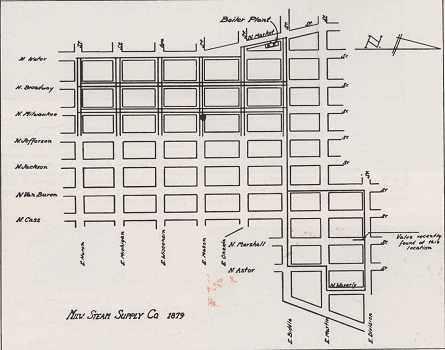

|
Chronological List of District Heating
Systems in the United States |
 |
 |
| Map of 1879 Steam System | Map of 2023 Steam System |
Milwaukee has had two separate district heating systems. The first was the Milwaukee Steam Supply Company that operated from 1879 to 1881 and the second began in 1906 and is still operating.
The Milwaukee Steam Supply Company was organized in April 1879 and began supplying steam in October. They had over 100 customers by the following May. Unfortunately for them, the winter of 1880-81 was one of coldest on record as was told by Laura Ingalls Wilder in The Long Winter. [Many thanks to my daughter Sara for making that connection.] Snow blocked most railroad traffic and prevented fuel deliveries, forcing the company to suspend operations on March 5, 1881, although a group of customers tried to keep it operating but had no money to fuel, etc.. This was the first of the Holly steam companies to fail, but would not be the last.
We Energies' steam system
dates to 1897 when a precursor company, The Milwaukee Electric Railway
& Light Co., bought several properties from beer baron Frederick
Pabst, as part of its acquisition of a rail line connecting Wauwatosa to
Milwaukee. The purchase included an electric plant on Broadway that was
already providing steam to the Pabst Theater and other nearby properties,
according to Milwaukee historian John Gurda's book, Path of a pioneer:
A centennial history of the Wisconsin Electric Power Company.
References
1879 "Articles of Association," Wisconsin
State Journal, April 15, 1879, Page 5.
Robert Eliot, John Black, Winfield Smith, H.H. Button, Alex. Mitchell, and
Wm. P. McLaren, as "The Milwaukee Steam Supply Company"; object:
producing, furnishing and selling within the county of Milwaukee steam to
be used for heating, furnishing power for other purposes; capital stock
$150,000; location of offices, city of Milwaukee.
1879 "Steam
on Tap," The Pantagraph, November 6, 1879, Page 4.
The Holly Heating Systems -- Some account of the Milwaukee Steam Supply
Company.
1880 "Steam
Heating," The Buffalo Commercial, May 19, 1880, Page 4 | Part
2 |
Letter from L. A. Wheeler, Secretary of the Milwaukee Steam Supply
Company.
8-inch pipe, 2,540 feet
10-inch pipe, 545 feet
6-inch pipe, 5,156 feet
4-inch pipe, 5,195 feet
3-inch pipe, 1,300 feet
5-inch pipe, 875 feet
Total 15,561 feet
Also have put in over 6,900 feet of service pipe. We now have over
one hundred customers. Are heating about 5,000,000 cubic feet of space in
buildings and dwellings. Are furnishing power to about ten engines, about
sixty horse-power (20 down to 2 each)
1881 The
Fall River Daily Herald, February 3, 1881, Page 4.
The Milwaukee Steam Supply Company has had a hard road to travel With
experiments in smoke consumption cheap fuel and aa exceedingly cold winter
it has been forced to levy an assesuient of 50 per cent on the
stockholders- Some of the patrons think it would serve the stockholders
just right if the assessment was 1000 per cent.
1881 "Notice,"
The Daily Republican and News, March 5, 1881, Page 2.
Milwaukee, March 4, 1881 - The directors of the Milwaukee Steam Supply
Company have turned over the steam works to the undersigned committee of
the consumers of steam. Said committee have parped an agreement to
be signed by parties desiring to be furnished with steam the remainder of
the season, which agreement is open for signature at the company's office,
No. 496 Market street. Steam will be shut off from all parties not
signing the same prior to Saturday evening, March 5.
1881 "At
Milwaukee," Wisconsin State Journal, March 5, 1881, Page 1.
In Milwaukee, the Steam Supply Company, which furnishes heat to hundreds
of residences and ateam to factories, could get no fuel on credit, and
suspended, and put the management into the hands of a committee of
stockholders. Coal is $12 a ton and wood $9 a cord; both are almost
impossible to get; dealers are selling coal at $1 for two bushels.
1881 "In
Trouble Again," Chicago Tribune, March 15, 1881, Page 8.
Special dispatch to the Chicago Tribune.
Milwaukee Wis.. March 14. The patrons of the bankrupt Steam-Supply
Company held an excited meeting' this evening.. The Company turned
the buildings and boilers over to the consumers a fortnight ago, and
assessments and pledges were then made which have not been honored.
The concern therefore, finds itself in a second decline, there not being
any money with which to buy coal or pay other expenses. It will be
determined to-morrow whether it will be kept running or not..
1906 History
of Dane County: Biographical and Genealogical
Page 311: Peter Gauer received his education and learned the
machinests' trade in his native country. In 1873 he came to this country
with his parents and entered the employ of a furniture firm in Milwaukee
as fireman. He remained with this concern some three years, becoming
engineer after the first six months' service. He then became foreman of a
pipe-laying gang for the Milwaukee steam supply company, a company which
supplied steam for heating and power to residences and business houses.
The company had thirty-three boilers in operation, each supplying over one
hundred horse-power. When the pipe-laying was done he entered the works as
foreman of the firemen and six months later was promoted to the position
of engineer.
1955 "The
Granddaddy of Central Station Heating," District Heating
41(1):24-26 (July 1955)
Uncovering of old valve recalls pioneer steam distribution system.
1956 "Museum
Piece is Unearthed," District Heating 41(4):129-130 (April
1956)
76 year old unusual heating system junction box discovered.
1996 Path
of a pioneer : a centennial history of the Wisconsin Electric Power
Company, by John Gurda
Page 46: Both lines were owned by brewer Frederick Pabst, whose
summer farm (now the elegant Washington Highlands subdivision) happened to
lie in Wauwatosa.
The $770,000 purchase also brought a pair of powerhouses into the TM
system: a railway plant in Wauwatosa and a lighting plant on Broadway in
downtown Milwaukee. Waste steam from the Broadway plant's boilers was
piped underground to provide heat as well as light to the Pabst Theater,
the Pabst-owned St. Charles Hotel, and other buildings on the east side of
the river. (It was thus the earliest instance of cogeneration —
simultaneous production of thermal and electrical energy — in what became
the Wisconsin Electric system.)
Page 56: The basement housed a cogeneration plant that provided
electricity and steam heat for TM's headquarters and other downtown
buildings. (The East Wells plant shared the steam load.)
Page 108: By 1925 the plant generated 86 percent of the TM system's
electricity, leaving the Commerce and East Wells facilities to produce
steam heat and standby power.
Page 166: The East Wells "boiler house" was completed in early 1939,
and Commerce Street’s followed in late 1941. Although the new units were
designed to serve the steam heating system in downtown Milwaukee, they
added nearly 50,000 kilowatts (roughly 10 percent) to WEPCO's capacity.
Page 200: In February, 1966, while work on the eighth and final unit
at Oak Creek was still under way, Wisconsin Electric unveiled plans for
two new power plants. The first was a 140-megawatt cogeneration plant
designed to share, and eventually take over, the steam-heating load
handled by the aging Commerce and East Wells powerhouses.
Page 201: The Valley plant's first unit was dedicated in July, 1968,
with Gov. Warren Knowles in attendance, and the second was finished in
March, 1969, just in time to serve the steam system's newest and largest
customer: Marquette University.
2015 SEC
form 10-K WE Energies
2015 2014 2013
Pounds of steam sales (in millions) 2,515 2,865 2,750
2023 "Steam
has provided heat and power for downtown Milwaukee for 125 years. Why?
And what's its outlook in a green-energy future?" Milwaukee
Journal Sentinel, July 5, 2023
The 400-plus customers connected to the steam system are a small, but
important, part of We Energies' business.
© 2024 Morris A. Pierce